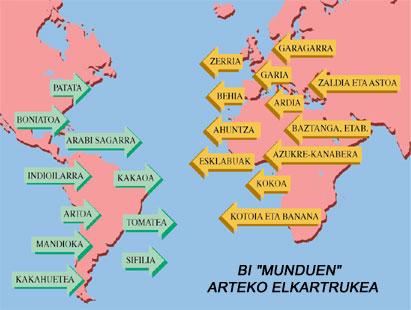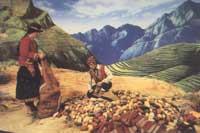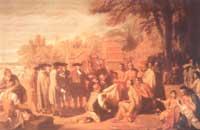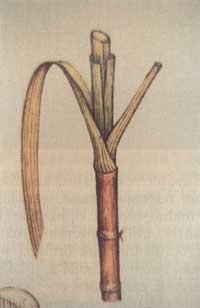The "Discovery" of America: Shaking Ecology

We know that Christopher Columbus was not the first to “find” America. The Basque fishermen arrived on the American coast long before. But the fishermen were not conquerors. And before the Basques, about a thousand years ago, the Vikings traveled to America (that's why the Scandinavians say that you have to bluff the fifth centenary and celebrate the tenth instead of the fifth). But it was Christopher Columbus who discovered the political dimension of the discovery and spread the new to all of Europe.

But, to be clear, America is not the “New World.” When on October 12, 1492 Columbus landed on the island of San Salvador, America was as old as Europe. And it had enough for Europe to offer it. The New Real World is what Americans and others have lived through since then. In fact, the consequences of marginalization between two unknown continents for thousands of years have been the greatest in the history of civilization.
Some of the conclusions, as we will see, although beneficial, were very harmful. The conquerors made two main anti-ecological sins: Europeans considered them as beasts and animals to exploit and dominate the peoples of America and not as human beings of the same level, who had a culture as old and rich as the European. On the other hand, they did not notice the fragility of the American environment. Consequently, civilized Europeans have almost completely destroyed what nature has generated for thousands of centuries.
The exchange between the new continent and Europe (more Africa and Asia) began in 1493 with the second trip of Columbus. This journey, aboard seventeen ships, landed some 1,500 men, several women, horses, cows, pigs, chickens, wheat, barley, other seeds and sugar cane on the beaches of Haiti. In this exchange we will distinguish four large groups: plants, animals, humans and diseases.
Plants
In edible plants, if we speak of importance, the balance is undoubtedly directed to America. The data are:

Sugar cane, main crops (wheat, barley,...), vine, onion, orange, pear, etc. they took them. From America the beans (beans = Indian beans), cassava, cassava, peanut and, above all, cocoa, tomato, potato and corn. Without them, today we would have an Italy without tomato sauce and a Switzerland without chocolate and in our bars there would be no pintxos of potato omelette. Unthinkable, right?
The potato is a plant of the Peruvian plateaus that spread slowly throughout Europe. Apparently, one of the first people to know the potato in Europe was Euskal Herria. XVI. At the end of the 20th century we reached our shores. He arrived in Ireland later in the 17th century. In the mid-twentieth century, and soon after became the staple and main food of the Irish. XVII in mid-Europe. It only arrived at the end of the 20th century. Chinese XVII. It arrived in the 19th century.
It is a fast growing potato plant, which does not require strict gardening or climatic conditions and which, among those that meet these conditions, provides the highest number of calories per hectare. To realize the importance of plants of American origin in our food today, there is nothing more than looking at world production: In 1986, the joint production of wheat and rice considered the most basic amounted to 1,000 million tons, while the joint production of corn and potato reached 788 million tons in the same year.
Animals

In animals, however, the contribution of America is scarce. Turkey (turkey = Indian rooster) is the only animal that has been brought to us from home. The rest of animals and animals of the American fauna, such as the flame, the guanaco or the condor, have not left their place of origin.
On the contrary, the list of “migrated” animals from Europe to America is extensive and has great influence. In fact, the Indians of far-west films or the Argentine gaucho are not represented without horses. However, the horse was totally unknown (and even unthinkable) to the Indians. The knight and the horse, the Indians thought that the two were the two, seeing for the first time the conquerors over the horses.
The horse adapted perfectly to the extensive meadows of South America and North America and the XVII. Since the beginning of the 20th century, the lives of the Indians changed profoundly. Siux and the comanches, for example, were a popular rural seminomada, but thanks to the horse, they became nomadic bison hunters, following migratory bison groups.
Donkeys, sheep, goats and pigs from Europe adapted to the new continent and along with the species of origin were and are source of food and labor force for Americans. However, the continental damage caused by pigs is not negligible. Due to their great fertility (two or three stages a year and eight or ten pigs per breeding) and their omnivorous character, the escaped wild humans ate all kinds of animals and plants. Just a century was enough for pigs to colonize all of America, from Nova Scotia in North America to the Tierra del Fuego in South America. They caused irreparable damage to native fauna and flora.
Human

From the ecological point of view, the “discovery” of America meant for the human species the greatest shock until then. A race, the white, appeared all over the world. The other races were forced to submit to him and suffer his horrors. Many American peoples disappeared. It was genocide. The Amerindians were forced to work (in sugar cane, first, in cotton and then in tobacco). Working conditions and diseases made the population of origin disappear. The substitute was the African black population. As if they were animals, Africans were gently brought to America by slave traders.
The first black slaves arrived 13 years after Columbus' arrival in America in 1505. The slave market expanded enormously and in a few years 10 million Black people were extracted from Africa to work in America. The death rate of slaves in sugar cane plantations was enormous: a average slave dies per ton of sugar produced. The native population of the Caribbean has been fully represented by the black population from Africa.
Retroactive disease
All the changes caused by the conquerors are reduced after the terrible effects of the epidemics. The conquerors imposed themselves with relative ease, but this would not have been so easy if the typhus, the seedlings and, above all, the smallpox had not broken or weakened the solid empires originating from Central and South America.

Baztanga was an endemic disease in Europe. VI. It reached Europe in the 19th century through Muslim invasions and gradually spread. XVIII. In the 18th century 10% of Europeans died from smallpox. However, VII. Since the 20th century the European population had developed some immunity.
It seems that the shipyard Juan Nepomuceno was the first that in 1492 took him to America with the same baztangas. The epidemic spread rapidly among Amerindians. Between 1519-20 he died hundreds of thousands of Aztecs, facilitating the conquest of Hernan Cortés. In 1525 the epidemic reached the Inca territory: The Great Inca died and the army weakened. When Pizarro came for the second time to the Peruvian plateaus in 1532, he discovered a sump town, desolate by the smallpox.
The epidemic expanded very quickly. Since the arrival of the Caribbean Columbus, a century was enough to reduce the number of original populations to 10%.
Despite being oppressed, weakened, raped and exploited by Europeans, American revenge soon spread to Europe. The conquerors, along with American gold and silver, brought syphilis. Baztanga ended Central American civilization; syphilis did not sink European civilization, but its effects and consequences were terrible. XV. Syphilis arrived in Spain in the late 20th century and spread rapidly throughout Europe through the Italian wars. Old and young, rich and poor, were matched by syphilis. For example, Charles VIII of France died of syphilis in 1498, when he was 28 years old.

The “Italian”, “French”, “Spanish”,... the Europeans mutually attributed the origin of the disease. Seeing the social rejection that AIDS (Acquired Immunodeficiency Syndrome) has produced these days and the irrational fear of those affected by AIDS, the XVI. In the eighteenth century it is easily appreciated how syphilis shook the social customs and cultural environment of that time. Until then, the relationship between sin and the penalty of God had a metaphysical character (hell), but it suddenly materialized. Luxuria, the body of sinners that sewed with fleshy chickens that shed pus. He was called “the punishment of God.” The bathhouses were closed and the Inquisition, the imposition, the religious wars and the prophetism crossed all over Europe. Meanwhile, across the Atlantic Ocean, dominated America would go.
The encounter between two worlds that have developed without news for hundreds of thousands of years has occurred only once in the history of humanity. Relations between different societies occur progressively in space and time. However, the 1492 was a great cultural dance for the American peoples, a total explosion. We will learn from the abuses of that time!
Sugar reeds enjoy Europe, amamarga America and Africa

Sugar cane was grown in Asia and some parts of Africa (such as China and the Canary Islands) before reaching America, but production was small and not very important. Sugar was very expensive. The first cane plantations in Haiti yielded an excellent harvest and were quickly opened to Cuba, Puerto Rico, Jamaica and Brazil. Thousands of hectares of tropical forest were plowed to plant cane.
To produce the land, plant it, work it, wrap it, remove the juice and prepare the crystallized sugar and other by-products, a lot of labor was needed. Native Americans, the Amerindians, were forced to do so. But diseases from Europe (baztangas, typhus, seeds, measles, etc.) close to 90% of the original population ended in a few years. Then, to replace it, they took the blacks from Africa.
Until then sugar was an expensive product, it became a market and a very important industry. XIX. When the industrial procedure for obtaining sugar from beet was discovered in the early 20th century, most reed plantations gradually disappeared.






